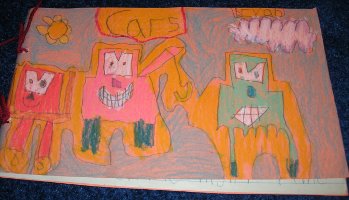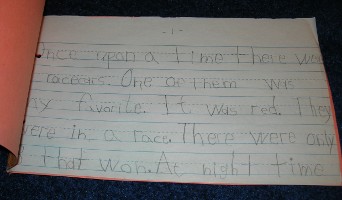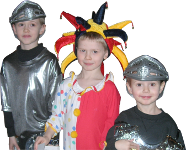Reading and Writing: The Early Years
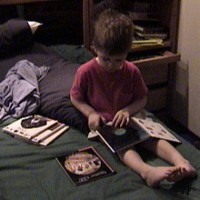 You can easily teach your baby to read by flashing a black-and-white alphabet, saying the sound of each letter. (Don't say the letter names, and only use short vowels.) All of my babies could read at age one and a half, and they felt empowered. It took less than 60 seconds a day, and I skipped lots of days when I was too tired. I wrote with a thick black marker on blank white cards that I made myself. Eventually I laminated them because I was using them so much.
You can easily teach your baby to read by flashing a black-and-white alphabet, saying the sound of each letter. (Don't say the letter names, and only use short vowels.) All of my babies could read at age one and a half, and they felt empowered. It took less than 60 seconds a day, and I skipped lots of days when I was too tired. I wrote with a thick black marker on blank white cards that I made myself. Eventually I laminated them because I was using them so much.
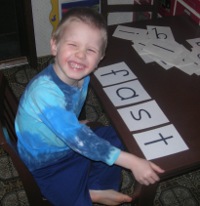 I used the same pack of cards to play spelling games when the kids were 3 and 4 years old. I would call out a word, and they would spell it with the cards. I would use colorful refrigerator letter magnets to spell out words for them to read, or I would use alphabet blocks to do the same thing. You can also match words to physical items (like a plastic elephant to the word “elephant.”) Or I would write the color words with an empty box, and they could read the word and choose the correct crayon color. Or I would write words on the dry erase board or the Magna-Doodle. Once they start reading, make sure they read a few words each day, so that they can progress.
I used the same pack of cards to play spelling games when the kids were 3 and 4 years old. I would call out a word, and they would spell it with the cards. I would use colorful refrigerator letter magnets to spell out words for them to read, or I would use alphabet blocks to do the same thing. You can also match words to physical items (like a plastic elephant to the word “elephant.”) Or I would write the color words with an empty box, and they could read the word and choose the correct crayon color. Or I would write words on the dry erase board or the Magna-Doodle. Once they start reading, make sure they read a few words each day, so that they can progress.
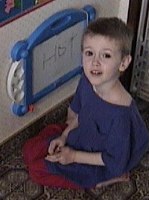 Boys are notorious for not being able to write at an early age. Mine could write at 3 or 4 years old. Once again, I did almost nothing. I had a magna doodle bolted to the wall, so my babies and toddlers had plenty of practice in fine motor skills throughout the day with no energy expenditure on my part. (I removed the stamps because I kept stepping on them, but the pen is attached to the Magna-Doodle, so it's a toy that you never have to clean up that has endless possibilities for play.) Another idea for younger toddlers is to tape down a paper and give them a thick crayon. They will experiment until they figure out they have the power to make marks.
Boys are notorious for not being able to write at an early age. Mine could write at 3 or 4 years old. Once again, I did almost nothing. I had a magna doodle bolted to the wall, so my babies and toddlers had plenty of practice in fine motor skills throughout the day with no energy expenditure on my part. (I removed the stamps because I kept stepping on them, but the pen is attached to the Magna-Doodle, so it's a toy that you never have to clean up that has endless possibilities for play.) Another idea for younger toddlers is to tape down a paper and give them a thick crayon. They will experiment until they figure out they have the power to make marks.
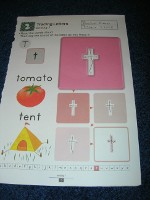 I recommend the colorful KUMON workbooks for 3-year-olds to learn to stay inside the path of an easy maze with a pencil. Then progress to upper-case letters, then lower case. This is the easiest way to learn to write, because it begins large and progressively gets smaller. If a child is frustrated at all, put it away for a few months and try again later. Writing is sort of like potty training; it is a physical skill rather than a mental skill.
I recommend the colorful KUMON workbooks for 3-year-olds to learn to stay inside the path of an easy maze with a pencil. Then progress to upper-case letters, then lower case. This is the easiest way to learn to write, because it begins large and progressively gets smaller. If a child is frustrated at all, put it away for a few months and try again later. Writing is sort of like potty training; it is a physical skill rather than a mental skill.
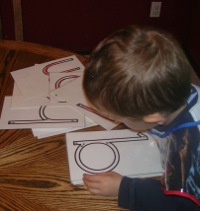 I laminated some cards that had empty block letters on white paper. I gave the child a black dry erase marker, and he followed the path of the letters. I would spill out some rice or flour on a tray for the toddler to write a letter by swishing his finger through it. That was always fun. A preschooler can spell words on the dirt or with popcycle sticks on the floor.
I laminated some cards that had empty block letters on white paper. I gave the child a black dry erase marker, and he followed the path of the letters. I would spill out some rice or flour on a tray for the toddler to write a letter by swishing his finger through it. That was always fun. A preschooler can spell words on the dirt or with popcycle sticks on the floor.
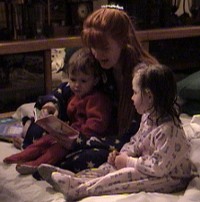 When you read books to children, always slow down and enjoy it, making different voices for the different characters. This will give your children a lifelong love of reading. You can stop and ask questions such as “Is the fox lying when he says he doesn't like gingerbread men?” Sometimes my four or five-year-old would read to a younger sibling with lots of theatrical flair and questions. I wonder where he learned that from?
When you read books to children, always slow down and enjoy it, making different voices for the different characters. This will give your children a lifelong love of reading. You can stop and ask questions such as “Is the fox lying when he says he doesn't like gingerbread men?” Sometimes my four or five-year-old would read to a younger sibling with lots of theatrical flair and questions. I wonder where he learned that from?
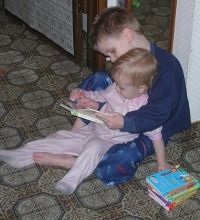 When teaching the classics of literature, toddlers and preschoolers can manage to understand heavier books if you let them watch the movie first. For example, if they've seen the cartoon movie of Charlotte's Web, even a toddler will be able to understand the book as you're reading it because they have a frame of reference. (This would also work for high schoolers who were studying Shakespeare. If you watch the video first, it is much more fun to read the real Shakespeare play because you know the basic plot and can then enjoy the finer aspects of literature.) This does not apply to any literature that is at your level or below, and most movies are not the same as the book, so you have to choose your movies wisely.
When teaching the classics of literature, toddlers and preschoolers can manage to understand heavier books if you let them watch the movie first. For example, if they've seen the cartoon movie of Charlotte's Web, even a toddler will be able to understand the book as you're reading it because they have a frame of reference. (This would also work for high schoolers who were studying Shakespeare. If you watch the video first, it is much more fun to read the real Shakespeare play because you know the basic plot and can then enjoy the finer aspects of literature.) This does not apply to any literature that is at your level or below, and most movies are not the same as the book, so you have to choose your movies wisely.
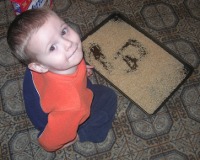 When your children can write letters fairly easily, they are ready to do some copywork. My four-year-old copied out a poem about the fall in an autumn lap book. She cut out pictures of autumn, did some leaf rubbings, and sprayed paint from a toothbrush onto a page with leaves on it. She had a ball and was very proud of her project.
When your children can write letters fairly easily, they are ready to do some copywork. My four-year-old copied out a poem about the fall in an autumn lap book. She cut out pictures of autumn, did some leaf rubbings, and sprayed paint from a toothbrush onto a page with leaves on it. She had a ball and was very proud of her project.
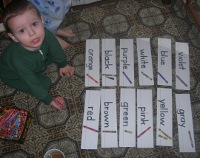 We did a planet book when one of my sons was 3 and a half. I described one planet, we watched a 5-minute video clip about that planet, and each child colored a picture of the planet. Then each child told me what he remembered about that planet. I wrote down his exact words. Then the 3-and-a-half-year-old copied the words that I had written into his book. After about two weeks, he had written his own book! My five-year-old boy had no problem writing his book either.
We did a planet book when one of my sons was 3 and a half. I described one planet, we watched a 5-minute video clip about that planet, and each child colored a picture of the planet. Then each child told me what he remembered about that planet. I wrote down his exact words. Then the 3-and-a-half-year-old copied the words that I had written into his book. After about two weeks, he had written his own book! My five-year-old boy had no problem writing his book either.
Your child can retell a fairy tale like “Goldilocks and the Three Bears.” He can illustrate it on the cover, then write the story on the inside of the book. Another son chose to write a summary of a movie we had seen. He illustrated it on the outside and wrote his story on the pages inside. These are some easy ways to incorporate reading and writing into the day for your young children.
For more information about this topic, go ahead and grab Cognitive Development in Early Childhood.
